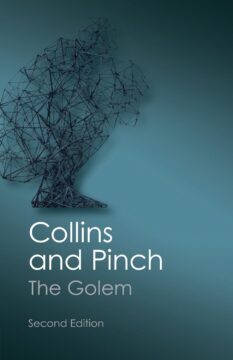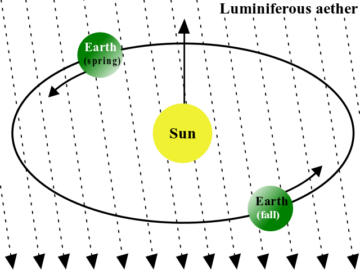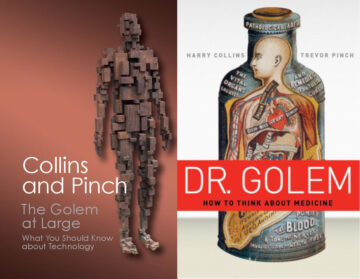by David Kordahl

On Tuesday and Wednesday of last week, I taught introductory physics students how to set up circuits. They struggled. They tried to connect capacitors one to the next but, upon hooking up the battery, would find that none had charged. Or, if some capacitors had charged, others would have voltages unaccountably higher than theory would imply. Students would call me over. I would run them through my standard jokes. “Did you have faith? Did you direct your psychic energy toward the circuit?” They would roll their eyes, and I would show them how to fix it. I have taught introductory physics many times, and I know the usual ways that laboratory exercises can fail. Students often find it frustrating when I am able to come to their lab stations and get setups to work that they had concluded were fundamentally broken.
Sociologists of science have long been interested in the tacit knowledge that introductory labs are intended to convey. In the controversial final pages of The Golem: What You Should Know about Science (1993), the British sociologists Harry Collins and Trevor Pinch compare all of science to a messy introductory lab. Each student measures a different temperature of boiling water. But even after that, the teacher is able to convince the students that water boils at exactly 100º C. “That ten minutes renegotiation of what happened is the important thing,” they insist. “If only, now and again, teachers and their classes would pause to reflect on that ten minutes they could learn most of what there is to know about the sociology of science.”
During the past few weeks, I’ve been revisiting The Golem and its two sequels, The Golem at Large: What You Should Know about Technology (1998), and Dr. Golem: How to Think about Medicine (2005), all co-authored by Collins, who today is at Cardiff University in Wales, and Pinch, who died in 2021. These books are entirely composed of case studies, and range from discussions of cold fusion, to macroeconomic predictions, to double-blind medical trials.
Collins and Pinch were early disciples of Thomas Kuhn, whose idea of “incommensurability” I discussed at length in an earlier column. Their first book together, Frames of Meaning: The Social Construction of Extraordinary Science, attempted to apply Kuhnian lessons to scientists studying parapsychology. That topic was self-consciously controversial, but in The Golem they turned to standard science, aiming to show non-specialists how the sausage is made.
The “golem” metaphor, here, stands for science itself—a clumsy and sometimes dangerous creature, animated by the word “truth” in its mouth. This golem, science, bumbles about without necessarily understanding what it’s doing:
We intend to show that it is not an evil creature but it is a little daft. Golem Science is not to be blamed for its mistakes; they are our mistakes. A golem cannot be blamed if it is doing its best. But we must not expect too much. A golem, powerful though it is, is the creature of our art and craft.
In retrospect, it’s a little surprising that these books caused much controversy. At no point do the authors suggest there is a method of inquiry better than science. But some scientists took issue with their “methodological relativism”—which is just another way of saying that the authors do not assume in advance the truth or falsity of any conclusion whose controversy they investigate.
Collins and Pinch came to the Golem series with shared interests in physics. Harry Collins had already written about ongoing efforts to detect gravitational waves, and Trevor Pinch’s early book on the solar neutrino problem remains one of the major sources on that history. Each of these topics gets a chapter in The Golem. However, the most contentious chapter about physics turned out to be “Two Experiments That ‘Proved’ the Theory of Relativity,” to which the physicist M. David Mermin devoted two separate rebuttal columns in Physics Today.
“Two Experiments”—the second chapter of The Golem—reviews classic episodes that all students of physics should recognize. The first is the Michelson-Morley experiment, which is typically trotted out in support of special relativity, the framework that Einstein introduced in 1905. The second experiment, the observed bending of starlight around the Sun during a solar eclipse in 1920, is used as experimental ballast for general relativity, Einstein’s theory of gravity.
Let’s look at just the first of these. The Michelson-Morley experiment was carried out some two decades before Einstein introduced special relativity. In the 1880s, physicists presumed that the medium for light was more or less like the medium for other waves—a type of physical stuff. The Earth, in its path around the Sun, goes in different directions during spring and fall, or summer and winter. Hence the Earth would move relative to that hypothetical medium for light, the “luminiferous aether”; this “aether wind,” as illustrated in the diagram below, was expected to have observable consequences in delicate optical experiments.

A rough model for physicists in the 1880s: Earth plows through the luminiferous aether, through which light travels. (Image from Wikipedia.)
Albert Michelson conducted one such delicate experiment in 1881, and repeated a more robust version of it with Arthur Morley in 1887, but no effect was observed. This “null result” is routinely cited as a motivation for Einstein in developing the special theory of relativity, one of whose postulates is that light in vacuum has the same speed regardless of the speed of the observer. Thus, in textbooks, is relativity born and the aether killed in one fell swoop.
Not so fast, argue Collins and Pinch. As discussions of solar neutrinos and gravitational waves make clear in other parts of The Golem, unexpected results cannot always be taken at face value.
Just as Morley succeeded Michelson, Morley also had a successor, Dayton C. Miller, who continued to refine their experiments at Western Reserve College in Ohio. But Miller did not get a null result—at least, he thought he didn’t. In 1925, he announced, from his experiments, that he could infer Earth’s relative movement in the aether to be about 10 km/s: smaller than the speed they had expected, but not zero.
And so what? So nothing. By the time of Miller’s observations, relativity had been woven into the warp and woof of modern physics. His claims changed few minds. Collins and Pinch insist this was not because Miller was a crank, but because the original null result had already been well accepted. “The meaning of an experimental result does not, then, depend on the care with which it is designed and carried out, it depends upon what people are ready to believe.”
When N. David Mermin, ordinarily among the sanest and most affable of the physicist-essayists, discussed this conclusion in the June and July 1996 issues of Physics Today, his irritation was palpable. Mermin accused The Golem of misleading its readers, who could not be expected to understand the breadth of evidence that lent legitimacy to the relativistic framework:
But what brings people into a state of readiness to believe or disbelieve an experimental result and its interpretation? The lay reader can only guess. Hardly a hint is given that this essay follows a single tiny strand in an enormous tapestry of fact and analysis.
Physics Today printed an exchange between Collins/Pinch and Mermin, but the parties talked past each other. Collins and Pinch denounced the “scientific fundamentalists” whose stubborn insistence on “creation myths” could “destroy the democratic foundation of the science they say they love.” For his part, Mermin charged Collins and Pinch with ignoring the real basis of scientific credibility. “Note, for example, that when they reaffirm their lack of ‘bias’ against relativity, they speak of beauty and culture, but not of truth, or even accuracy.”
Now, I am a physicist myself, so I appreciate Mermin’s basic point. If we’re going to re-adjudicate a historical debate, shouldn’t the facts matter? One can, after all, reexamine Miller’s data to assess its credibility. Thomas J. Roberts, a research professor of physics at the Illinois Institute of Technology, has done exactly this, and in examining the whole historical record (including both printed and handwritten material), he concluded that the case represented “every experimenter’s nightmare: [Miller] was unknowingly looking at statistically insignificant patterns in his systematic drift that mimicked the appearance of a real signal.”
Roberts’s analysis required quite a bit more effort beyond just reading and reporting on the original papers, but his conclusion is exactly what a mainstream physicist would expect—that special relativity is basically right, and that something was explicably wrong with Miller’s analysis. The neutral stance of Collins and Pinch sometimes glosses over problems like that, problems that, with more attention, might yield a more definitive result. Miller’s challenge to relativity certainly seems to me to be one such example.
The counter-argument, of course, is that no historical actors understood these details at the time, so they are hardly relevant to the arguments that Collins and Pinch advance. Their attitude is essentially that of “objective” journalists, of disinterested observers who want to represent all partisans. And if this attitude stops them from spotting methodological errors, it allows them to report a broader range of opinions than mainstream scientific accounts can accommodate.

I unabashedly loved all three Golem books. The chapters were just the right length to read one or two every night before bed, and since the world contains many controversies, I could imagine the series continuing indefinitely, with new installments every few years.
But as the second and especially the third book grew closer to topics of common concern, this indefinite extension came to seem less plausible. The Golem deals exclusively with problems in pure science, but The Golem at Large addresses technological failures, problems which admit no clean scientific solutions. Whether the questions are about the success rate of Patriot missiles in the Gulf War, or about who should have been blamed for the explosion of the Space Shuttle Challenger, these public questions all involve money, political power, and outright propaganda.
The difficulty of bracketing the scientific from the social is even more apparent in Dr. Golem, which begins with a discussion of how medicine has a dual purpose as “science” (i.e., in addressing the material causes of one’s sickness), and as “succor” (i.e., in providing hope that one’s sickness might improve). A few chapters retain the neutral tone of the first Golem—the dissection of Linus Pauling’s infamous advocacy of Vitamin C as a cancer treatment is especially good—but Collins and Pinch are upfront about the difficulties of remaining detached while observing medicine. Unlike the other sciences, one ignores medicine at one’s own peril.
The last chapter in Dr. Golem, “Vaccination and Parent’s Rights,” provides a remarkable ending to the series. It begins with a witty account of the game theory of child vaccination (should parents advocate that others vaccinate their children, while quietly refusing to vaccinate their own?), but breaks the fourth wall when the authors admit that they do not fully agree.
Collins had his children vaccinated on the recommended schedule in Britain, but Pinch, after moving the United States, opted out of a pertussis vaccine that, upon weighing the risks quoted in the medical literature, he judged to be more likely to harm than help his child. Was he right in this decision? Collins takes over the chapter, shifting the language from “we” to “I,” and Pinch becomes the subject of the last case study. I will not spoil the ending—suffice it to say that each party concludes that further developments vindicate his own decisions. Such is the way of that great golem, Science: “truth” may be in its mouth, but it’s often too clumsy to land any blows.
Since this is now the final paragraph, I’ll allow myself a half-baked observation. Contemporary assessments of scientific controversies frequently begin with the presumption that one side is acting in bad faith. This is sometimes reasonable, even when individual scientists are not purposefully dishonest. All organizations, from corporate offices to think tanks to academic departments, introduce selection effects. But what I found refreshing about the Golem books is that they avoid dismissing scientists out of hand. They take individual scientists seriously, and assume that they generally want to get things right. These books celebrate honest disagreement, since, as the afterward to The Golem puts it, “disagreements within science and technology…[do] not make for bad science; it is the repression of disagreement that makes bad science.”
Enjoying the content on 3QD? Help keep us going by donating now.
